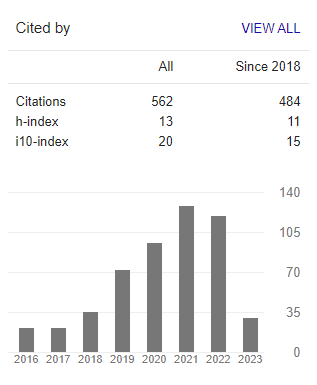THE PRACTICE OF DIGITAL PAYMENT CULTURE ON JUMP START COFFEE MACHINES: A Consumer FGDnography of Bakrie University Students
Abstract
This article focuses on the behavior of student consumers about their experiences of purchases through e-wallets based on the stage of exposure, attention, and interpretation. The qualitative research was conducted using the FGDnography method, that is, a focus group discussion on the nature of the topic. The FGDnography was conducted for eight Bakrie University student participants, Jump Start Coffee consumers. The results show that the experience of Jump Start Coffee digital wallet payment methods at Bakrie University was practical and amusing because Jump Start Coffee vending machines provide a lot of convenience for consumers. Although there are some deficiencies, Jump Start Coffee is still considered a practical vending machine, including cashless payments that have fulfilled the lifestyle needs of millennial young people.
To cite this article (7TH apa STYLE)::
Selvonia, F. & Kania, D. (2021). The Practice of Digital Payment Culture on Jump Start Coffee Machines: A Consumer FGDnography of Bakrie University Students. Journal Communication Spectrum: Capturing New Perspectives in Communication, 11(2), 139-149. http://dx.doi.org/10.36782/jcs.v11i2.2023
Keywords
References
Azizah, N. (2016, December 26). Mengenal Generasi millennial. Website Resmi Kementerian Komunikasi dan Informatika RI. https://www.kominfo.go.id/content/detail/8566/mengenal-generasi-millennial/0/sorotan_media
Bungin, B. (2011). Penelitian kualitatif: Komunikasi, ekonomi, kebijakan publik, dan ilmu sosial lainnya (2nd ed.). Kencana Prenada Media Group.
Isna, T. D. (2019, January 25). Tren mobile payment: Mayoritas pengguna ingin coba merek baru, kenapa? Warta Ekonomi. Retrieved November 3, 2019, from https://www.wartaekonomi.co.id/read213007/tren-mobile-payment-mayoritas-pengguna-ingin-coba-merek-baru-kenapa.html
Lancaster, L. C., & Stillman, D. (2002). When generations collide: Who they are. Why they clash. How to solve the generational puzzle at work. Harper Collins.
Laudon, K. C., & Traver, C. G. (2011). E-Commerce 2011: Business, technology, society (7th ed.). Pearson.
Mulyana, D. (2010). Ilmu komunikasi: Suatu pengantar (14th ed.). Remaja Rosdakarya.
Schneider, G. P. (2011). Electronic commerce (9th ed.). Course Technology.
Siregar, A. (2019, January 20). IMR 2019: Millennial pilih hidup cashless. IDN Times. Retrieved November 3, 2019, from https://www.idntimes.com/business/economy/ananta-fitri/survei-ims-2019-millennial-pilih-hidup-cashless
Solomon, M. R. (2015). Consumer behavior: Buying, having, and being (11th ed.). Prentice Hall.
Solomon, M. R., & Rabolt, N. J. (2009). Consumer behavior in fashion. Prentice Hall.
Tempo.co. (2019, July 15). Tiga Jenis Transaksi paling sering Digunakan dalam Dompet digital. Retrieved November 3, 2019, from https://inforial.tempo.co/info/1001272/tiga-jenis-transaksi-paling-sering-digunakan-dalam-dompet-digital
Wijaya, B. S. (2016). FGDnography: Discussing a topic in the nature of the topic. Journal Communication Spectrum: Capturing New Perspectives in Communication, 6(2), 176-200. http://journal.bakrie.ac.id/index.php/Journal_Communication_spectrum/article/view/1982
Yuswohady. (2016, January 17). Millennial trends 2016. yuswohady.com. Retrieved November 3, 2019, from https://www.yuswohady.com/2016/01/17/millennial-trends-2016/
Refbacks
- There are currently no refbacks.

This work is licensed under a Creative Commons Attribution 3.0 License.
Indexed by:
Archived in:
Listed in:
INTERNATIONAL ASSOCIATION FOR MEDIA AND COMMUNICATION RESEARCH

















